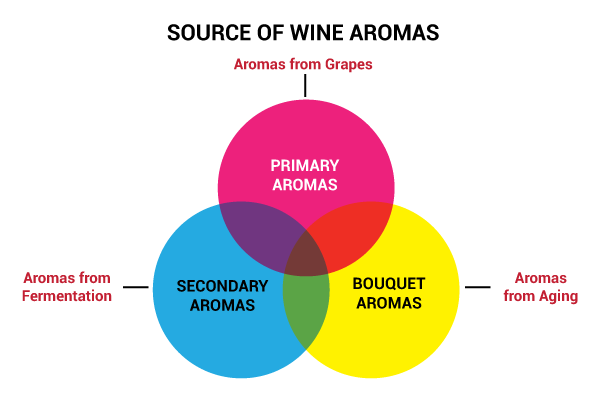An introduction to the flavors, aromas and colors of wine
Wine Traits
Drinking wine to enjoy it may seem uncomplicated. But understanding the layers of aromas and flavors, as well as where they come from, will bring tasting wine to another level of enjoyment.
Aromas
The aromas given off by wine go a long way toward how it tastes, and will likely be the first thing you notice when you open a bottle or pour a glass. Take a moment to breathe in the aroma before you taste the wine, as it will greatly enhance the flavor. Aromas tend to fall into 3 categories:
- Primary aromas, which come from the type of grape and the climate where it was grown. They can include fruits, herbs and florals.
- Secondary aromas, which come from the yeast in the fermentation process. They can include aromas of bread, cheese or nuts.
- Bouquet aromas occur when wine has been in aged in oak, such as the vanilla flavor the wine absorbs from its oak barrel. Bouquets can also include aromas of spices, cedar and smoke.

Flavors and Notes
Wine, of course, always starts with the grapes, and the grapes take on flavors from conditions in the surrounding vineyards. For instance, sea air may give coastal grapes a certain taste that the same grapes raised on a mountain would not have. Bees also play a major role as they pollinate grape flowers, spreading them with pollen collected from wild herbs, flowers and grass. The grapes will absorb those plant flavors as they grow.
Flavors are further influenced by the winemaker’s decisions on when the grapes are picked, how they are pressed and how they are aged. Little wonder that a wine’s final flavor can be much more complex than the type of grape it comes from.
Earthy
An aroma reminiscent of earth, such as mushrooms or wet leaves
Floral
The aroma of flowers, especially in a white wine
Grassy
The aroma of grasses or herbs; also referred to as “green”
Jammy
As in jam or jelly, a rich, concentrated fruit flavor, especially in Zinfandels or Syrahs
Mineral
An aroma of chalk, minerals or even stones, usually referring to a white wine
Smoky
A flavor or aroma in some wine which has been aged in oak barrels
Spicy
The aroma of a spice like pepper or cinnamon, perceived as an aromatic element
Toasty
A toasted, nutty or smoky aroma which comes from aging in oak
Yeasty
An aroma of bread of bread dough, often in sparkling wines and some white wines
Tannins
Tannins are chemical compounds food naturally in grape skins, seeds and stems. They’re released when the skins and seeds are soaked in the freshly-pressed grape juice (called “maceration”) that eventually becomes wine. Typically, maceration only occurs in the production of red wine, and tannins give reds the dry, slightly astringent taste sensation they are known for. The longer the skins and seeds remain in the juice, the deeper the wine’s color and the higher the tannins. A wine high in tannins is called “tannic.”
Color
Like tannins, wine gets its color from the amount of time the grape skins stay in contact with the juice. Deep reds have spent the longest time with the skins, taking on deep and bold flavors in the process. White wines spend almost no time with the skins, and remain light in color and flavor.
Acidity
Acidity adds a tart, crisp flavor to wine, and helps balance the sweet fruit notes with the bitter tannins. Like a citrus drink, acidity can make wine refreshing and helps it pair well with food. Normally acidity is associated with white wines, but even deep, mellow reds have a touch of acidity.
Body
Often a wine is described as being “light-bodied” or “full-bodied,” a reference to its viscosity, or thickness. Alcohol is responsible for viscosity, and the higher the alcohol in a wine, the thicker and heavier it tastes.
Examples:
Light-Body Wines
- • Sparking Wines
- • Riesling
- • Sauvignon Blanc
- • Pinot Gris/Pinot Grigio
- • Pinot Noir
Medium-Body Wines
- • Grenache/Garancha
- • Merlot
- • Sangiovese
Full-Body Wines
- • Cabernet Sauvignon
- • Chardonnay
- • Syrah
- • Viognier
- • Zinfandel